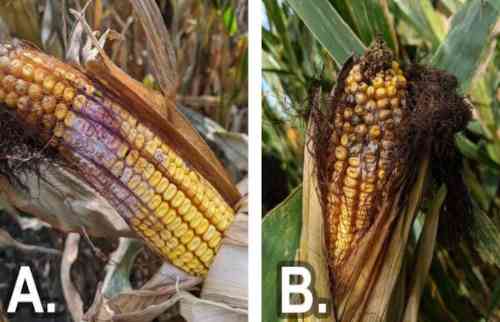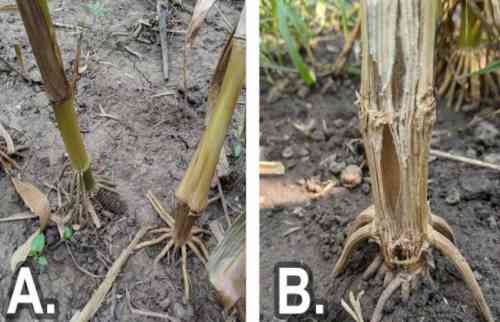By Emmanuel Byamukama
Before combining corn, it is recommended to scout your field for corn ear rots and stalk rots. Corn ear rots can compromise corn grain quality and stalk rots lead to lodging of corn plants. Lodged plants pose combining issues and downed plants which have ears touching the soil can lead to ear rots. It is important to scout corn fields for these two issues in order to make timely decisions on corn combining.
Ear Rot
Ear rots are caused by several fungal pathogens but the common ones in South Dakota include Gibberella ear rot and Fusarium ear rot. The pathogens which cause these two ear rots can also lead to mycotoxin accumulation in the grain. Gibberella ear rot can be differentiated from Fusarium ear rot by the color of infected kernels. Gibberella ear rot (also called red rot) is characterized by the reddish-pinkish color on infected ears (Figure 1-A) and tight husks which adhere to the ear. Infection may start at the tip of the ear and may expand down the ear. Fusarium ear rot can develop as scattered or clustered kernels on the ear with whitish – lavender fungal growth (Figure 1-B). Fusarium ear rot tends to develop in ears with injury caused by bird/ insect feeding or hail damage. However, this ear rot can occasionally develop in uninjured ears of susceptible hybrids.

Figure 1. A) A corn ear showing Gibberella ear rot symptoms. The pinkish color is a sign of Gibberella spp. B) A corn ear with kernels infected with Fusarium spp.
DECISIONS TO CONSIDER FOR FIELDS WITH EAR ROTS
- Walk corn fields and check 10 random ears at 20 stops in the field. If >10% of ears in a field have >10-20% moldy kernels, the field should be scheduled for harvest as early as possible.
- Care should be taken to do little to no damage to the kernels during harvest. The grain should be cooled and dried to <15% moisture content immediately after harvest.
- Grain from fields where ear rot was a problem should be stored in a separate bin to avoid contaminating grain with no ear molds.
MANAGEMENT
- Select hybrids with high scores for ear rot resistance/tolerance.
- Practice tillage (where practical) and rotation (rotate away from corn and small grains) to reduce overwintering inoculum.
- Control insects that can cause wounds on ears.
- Store infected grain separately to avoid contaminating the entire bin.
- Dry grain to < 15% moisture if grain is to be stored through the next summer.
Stalk Rot
SCOUTING
Stalk rot symptoms include prematurely dried plants with a discolored rind (Figure 2-A). Splitting such stems reveals disintegrated pith (Figure 2-B) that sometimes may be discolored. To assess for corn stalk rots, gently push at least 10 corn stalks to an angle of 45o at a minimum of five random stops within a field. Stalks with rots will crumple at the first or second node above the soil line and may fail to regain an upright position. Fields with 10% or more stalk rot incidence should be harvested early to avoid lodging when high winds pass through. Some of the corn fields that had early frost injury may be prone to stalk lodging.

Figure 2. A) A healthy green corn stalk with healthy roots (left plant) contrasted with a corn plant lodging (right) when slightly pushed due to Fusarium stalk rot. B) A prematurely dried corn stalk split to reveal pith disintegration due to stalk rot.
MANAGEMENT
For future seasons:
- Select corn hybrids with a high rating of stalk strength and stalk rot resistance to manage stalk rots.
- Use cultural practices such as good fertility program, proper plant populations, and other practices to reduce plant stress which can lessen the chances of stalk rot development.
- Fungicides do not directly control stalk rots but may help in keeping the plant healthy in locations of moderate to high foliar disease pressure (control of fungal leaf diseases) and hence helping the plant to fend off stalk rots. However, the decision to apply a fungicide in corn should be driven by the potential for fungal leaf diseases to cause yield loss and not solely by plant health benefits.
Source : sdstate.edu